경기문화재단
Anyang_Looking for Modern Cultural Heritage in Gyeonggi-do
Anyang in our Memories... and its Less Conspicuous Heritages
As a province adjacent to Seoul, the country's capital city, Gyeonggi-do has inherited a vast amount of Korea's modern cultural heritage as the country has undergone a turbulent modern history, ranging from the latter part of the Joseon Dynasty to the Japanese Occupation Period followed by the national liberation and division, the Korean War, and the impressive industrialization and democratization processes. “Modern Cultural Heritage of Gyeonggi” will feature an introduction to the modern culture of Gyeonggi-do together with a discussion about the history, identity and values of the Province in terms of cultural heritage. |
Writer | Hyunjung Lee
Anyang is an old city, named after Anyangsa, a temple located in present day Anyang Art Park. In 1941, Seoi-myeon was renamed Anyang-myeon, and Anyang-myeon was raised in status to Anyang-eup in 1949, then finally to Anyang-si in 1973. The city is bounded by Geumcheon-gu and Gwanak-gu in Seoul, also bordered by Gwacheon-si, Uiwang-si, Gwangmyeong-si, Siheung-si, and Gunpo-si. In 1994, some parts of Anyang were incorporated into Uiwang-si and Gunpo-si. Anyang was famous for light and manual industries as well as the grape farming until the 1960s and 70s, but now the factories have been moved out and farm areas redeveloped so that industry and farming both gradually decreased, taking the shine away from Anyang’s reputation as “the city of industry”.
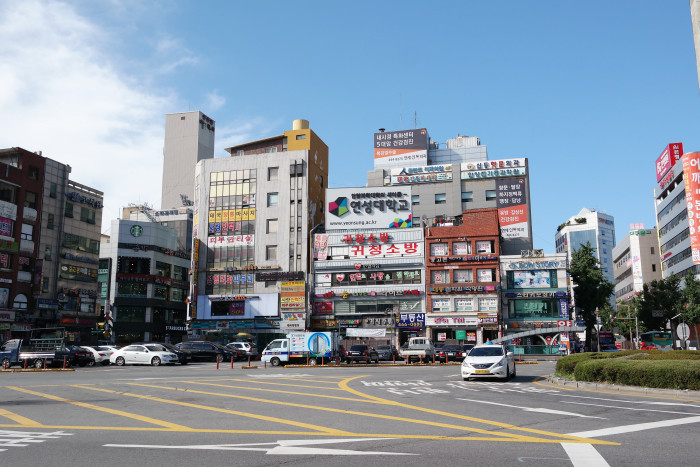
〈Landscape of Anyang station〉
The old downtown of Anyang is centered at Anyang 1st Avenue, around Anyang Station. It was already a busy place during the Japanese Colonial Era, clustered by official buildings such as Seoi-myeon Office, the police station, and the fire station. As time passed, it became even busier as bars, clothing shops, restaurants, accommodations, and markets were built. Afterward, the business zone has shared its visitors with the neighborhoods of Pyeongchon Station, Beomgye Station, and Indeogwon Station, the business districts in Pyeongchon, albeit reports that their visitors differ in age from those of Anyang. The old downtown of Anyang is frequented by the residents, although its growth rate is lower than the city itself.
Many cities have an old downtown that is dead, but this is not the case for Anyang. Anyang’s old downtown is one of the most crowded among those around Seoul. Perhaps it is due to the convenient transportation including the railway station and buses. Especially some decades ago, a large population visited from Gunpo, Ansan, and Siheung. At the time, Seoul was too far away, and Anyang was nearby for those visitors. They would have met friends in front of Chohung Bank or Bon Department Store, and spent time in Anyang 1st Avenue or done grocery shopping at Anyang Central Market. The downtown is a place of collective memory, not just for the residents of Anyang but for those living in neighboring cities as well.
Modern cultural heritages are not easily noticeable, however. The city welcomes rapid, brilliant change. Everything remains only in our memory. Chohung Bank, Anyang Jeonjinsang Welfare Center, Samwon Theatre, Anyang Department Store, Bon Department Store, and Byeoksan Shopping Center—all are now gone or have been altered greatly. By comparison, the Underground Shopping Mall of Anyang 1st Avenue is always crowded as it is located near Anyang Station and the city’s downtown. The Underground Shopping Mall at Anyang 1st Avenue connects two underground malls: the Anyang Underground Arcade that opened in 1978, continuing from Central Market to the central junction, where the Samwon Theatre had been, and the Underground Arcade of Anyang Station Square that opened in 1982.
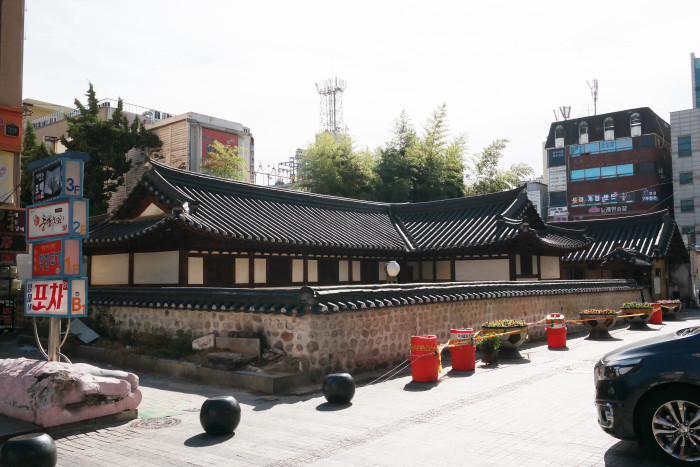
〈Seoi-myeon Office〉
On the way from Anyang 1st Avenue to Nambu Market, you can find the Old Seoi-myeon Office, Gyeonggi-do Cultural Property Material No. 100, standing alone. The office was established in 1914, the year Sangseo-myeon and Haseo-myeon in Gwacheon-gun were merged into Seoi-myeon. The building was built at another place at the time, and in 1917, it was moved to Anyang-ri, which became the center of Anyang. In 1941 it was renamed Anyang-myeon Office in Siheung-gun, and afterward was disposed of by sale when Anyang-ri was raised in status to Anyang-eup. In July 2002, Anyang-si purchased back and restored the building. It had been used as a hospital, a residence, and a Korean barbecue restaurant. The Former Seoi-myeon Office has an L-shaped structure, and a gambrel roof with the tip slightly raised, without short rafters at the tip. Some criticize the building as it was the site of Japanophilism and exploitation during the Japanese colonial period, but it is also evidence that Anyang 1st Avenue was the center of Anyang a long time ago.
At the northern end of Anyang 1st Avenue, we can find Nambu Market. It first opened as a wholesale market, and has developed into a market for both wholesale and retail. It had such a boom that there have been attendants who carry goods for customers with handcarts. Before the establishment of Anyang Agro-fishery Products Market at Pyeongchon-dong on September 6, 1997, Nambu Market sold agricultural products not only to the residents of Anyang but to those coming from Gunpo, Uiwang, Gwacheon, Ansan, and Siheung as well. It has fewer customers now, but there are still many shops selling agricultural products including fruits and vegetables and other food supplies.
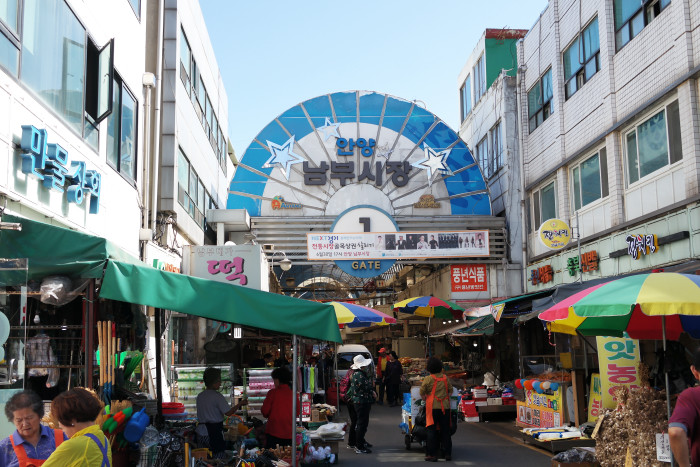
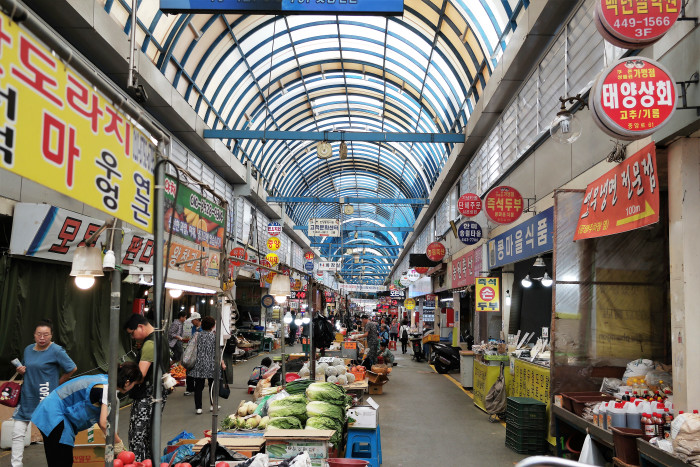
〈Anyang Jungang Market〉
Walking across Anyang-ro in the direction of Byeoksan Apartments, you can find Anyang Jungang Market. It has different characteristics from that of Nambu Market. It opened November 19, 1961, and was greatly expanded after the installation. It is a market that sells vegetables, marine products, and industrial products as well, and there are specialized alleys lined with fabric stores and sundae (Korean sausage) restaurants. On the weekdays, both Nambu Market and Anyang Jungang Market are rather quiet. They don’t seem like the energetic old downtown of the city. However, they are lively on the weekend, becoming quite crowded markets, indeed.
The Central Catholic Church of Anyang may be the reason that the two markets are so busy during the weekend. The church is the work of architect Kim Young-sub, who has designed a number of churches. There are several churches designed by him in Gyeonggi Province alone: Baran Catholic Church at Hyangnam-eup, Hwaseong; Simgok Catholic Church at Simgok-dong, Wonmi-gu, Bucheon-si, and Anyang Catholic Church. Baran Catholic Church is charming with its parodic roof in the Korean traditional residential style roof, and Simgok Catholic Church is impressive with its shape of a huge egg.
Strictly speaking, as a contemporary architectural structure that was built in 1991, Anyang Central Catholic Church is hard to call a modern cultural heritage, but it has spent 26 years in harmony with the traditional markets. Those visiting the church for the first time may have difficulty finding it because its main building is located separately from the main market street. The L-shaped structure, however, allows the visitors a quiet, relaxed time to enter the interior. As it is folded and divided, the design of the church doesn’t feel overwhelming despite the large 2,500-seat scale. It also has a large yard, where many people can gather from the crowded old downtown, making it possible to become the center of the local society.

〈Anyang Central Catholic Church in 1999〉**

〈Anyang Centeral Catholic Church〉
Now, it is time to look for the heritages from the modern age.
In a quickly-shifting old downtown such as Anyang’s, it is not easy to preserve the architectural heritage as a whole. Partial preservation may be practical—keeping some symbolic structures intact. For example, Noritake, a famous brand for its tableware, left behind their partial structures when they moved their Nagoya factories. Their chimneys were the highest in Nagoya in the early 20th century, so they wanted to preserve them. Noritake Garden (ノリタケの森, Noritake no Mori) was made with a third of the former facilities following their 100-year-anniversary plan, which was devised while the removal of the whole buildings was under consideration in 1978, when they moved out of Nagoya. The cluster of red buildings has been used as the museum and art museum, the history center of the company, the exhibition hall, the shop, and the experience center. The chimneys were kept after cutting their height, and the kiln sites were also preserved. The bricks left from the demolition turned into the wall. This is a good example of preserving a collective memory.

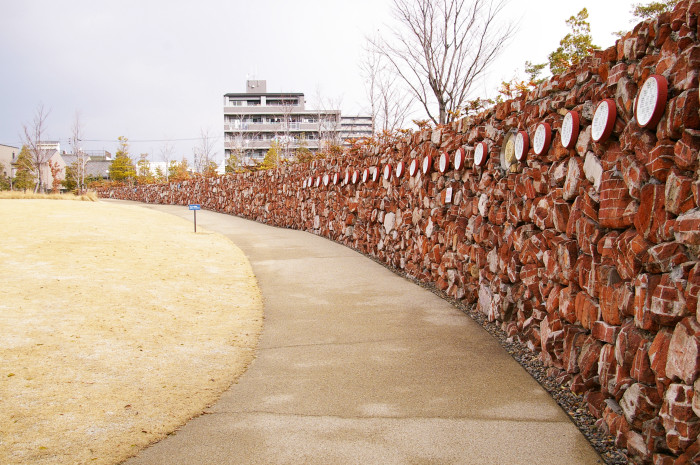
〈Noritake no Mori wall〉
Let’s examine Samdeok Park in the way that you saw Noritake no Mori. Once, there were factories to manufacture printing paper. In July 2003, the company donated the site with the purpose of making it into a park for citizens with the chimneys as a preserved symbol. However, the old chimneys were removed in May 2005. The newly-constructed chimneys are only sculptures, while the old ones would have been evidence of locality and a reminder of the old memories. Relieving the parking problem can be an excuse because it is based on reality, but to resolve the problem and to make the park a historical site also would have been realistic. The city had planned for a parking area and built new chimneys, but as reported in the article of April 27, 2017, the parking place is still in planning. To make the neighboring markets a better place for shopping, with a thousand shops and over 20,000 visitors, parking is the issue that needs to be addressed. Discussing locality without thinking of reality would be in vain. Thus, sharing ideas and planning meticulously in advance is the process that is required.

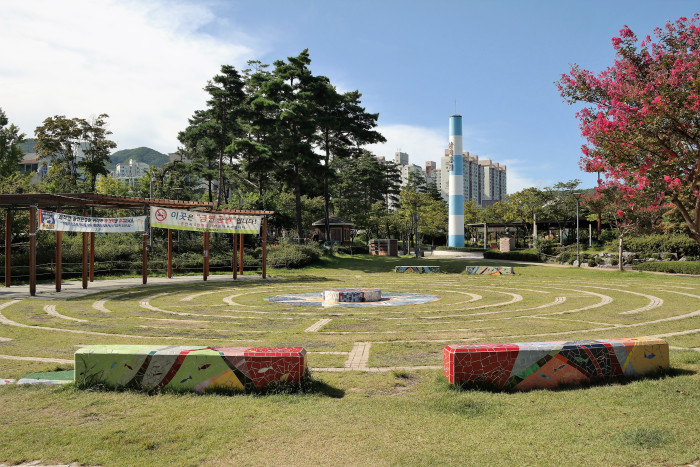
Watching the new chimneys reminded me of the factory site that I had seen during the preparation of Report on Researching and Listing of Modern Cultural Heritage of Gyeonggi-do in 2004. In July that year, the old main gate and security office of Dong-il Corporation were still in front of the apartment complex in Pyeongchon-dong. They were not purposely preserved, but ended up staying. Rather than having a high architectural meaning or value, the structures could be a trace of a number of factories that once had been in the eastern part of Anyang. On the report, there is an interview cited saying that a commercial building will be built on that spot. As I discovered, the gate and the office had disappeared and a common shopping mall for the residents had been constructed instead. This change makes the area a mere new town full of apartment buildings. Would it have been unreasonable to preserve an old memory in front of one of them?

〈security office of Dong-il Corporation〉
Is it merely romantic to think about preserving our past memories? We need to build a city whose history is alive in harmony with its current situation. It can be done by recovering not only the structures but the roads, plots, and collective memories. With its successive culture, the city will arouse the affection of its residents towards their community, reviving its identity and locality. As one of the members who shares the collective memory, I hope for a special place to be created in which we can feel pride and a sense of mutual understanding.
** A collection of Architect Kim Young-sub - Editorial team, Nanam Publishing House, September 15, 1999, p.200
<ggc의 모든 콘텐츠는 저작권법의 보호를 받습니다.>
세부정보
Modern Cultural Heritage in Gyeonggi-do
Writer/ Hyunjung Lee